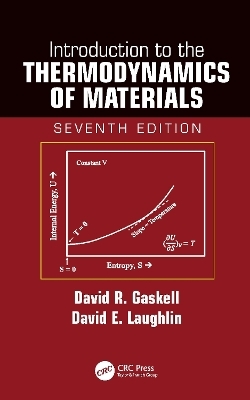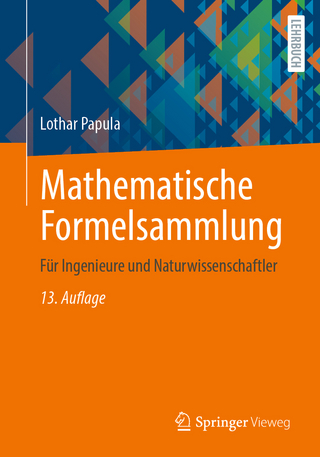
Introduction to the Thermodynamics of Materials
CRC Press (Verlag)
9781032450995 (ISBN)
Maintaining the substance that has made Introduction to the Thermodynamics of Materials a perennial bestseller for decades, the Seventh Edition is updated to reflect the broadening field of materials science and engineering. Chapters are updated and revised throughout to be more useful and logical for students.
Features more than 60 new homework problems for the students, a listing of terms and concepts introduced, and a summary section
Includes more on mathematical and graphical analysis of the various state functions utilized in classical thermodynamics
Includes a more extensive discussion of the third law of thermodynamics
Features a new appendix on exact differential equations and mathematical relationships, including all mathematical relations among differentials of homogeneous functions utilized in the text
Written as the definitive introduction to the thermodynamic behavior of materials systems, this text presents the underlying thermodynamic principles of materials and their applications and continues to be the best undergraduate textbook in thermodynamics for materials science students. An updated solutions manual is also available for qualifying adopting professors.
David R. Gaskell earned a BSc in metallurgy and technical chemistry at the University of Glasgow, Scotland, and a PhD at McMaster University, Hamilton, Ontario, Canada. Dr. Gaskell’s first faculty position was at the University of Pennsylvania, where he taught from 1967 to 1982 in metallurgy and materials science. In 1982, he was recruited at the rank of professor by Purdue University, West Lafayette, Indiana, where he taught until his death in 2013. During Dr. Gaskell’s career, he served as a visiting professor at the National Research Council of Canada, Atlantic Regional Laboratory, Halifax, Nova Scotia (1975–1976), and as a visiting professor at the G. C. Williams Co‑operative Research Centre for Extraction Metallurgy, in the Department of Chemical Engineering, University of Melbourne, Australia (1995). He also held a position during his sabbatical in Australia as a visiting scientist at the Commonwealth Scientific and Industrial Research Organisation (CSIRO) in Clayton, Victoria. Dr. Gaskell authored the textbooks Introduction to Metallurgical Thermodynamics, Introduction to the Thermodynamics of Materials, and Introduction to Transport Phenomena in Materials Engineering. David E. Laughlin is the ALCOA Professor of Physical Metallurgy Emeritus in the Department of Materials Science and Engineering at Carnegie Mellon University (CMU), Pittsburgh, Pennsylvania. He also had a courtesy appointment in the Electrical and Computer Engineering Department. He was the principal editor of Metallurgical and Materials Transactions from 1987 to 2016. David is a graduate of Drexel University, Philadelphia, Pennsylvania (1969), and the Massachusetts Institute of Technology, Cambridge, Massachusetts (1973). He is a fellow of the Minerals, Metals and Materials Society (TMS), an honorary member of the American Institute of Mining, Metallurgical, and Petroleum Engineers (AIME), and a fellow of ASM International. He is also the recipient of several CMU awards for teaching and research excellence and was named a distinguished scientist of the TMS Electronic, Magnetic, and Photonic Materials Division. He presented the 2017 ASM Campbell Memorial Lecture and is the recipient of the 2025 ASM International J. W. Gibbs Award. He has authored more than 500 technical publications in the field of phase transformations, physical metallurgy, and magnetic materials; has been awarded 12 patents; and has edited or coedited seven other books, including the fifth and sixth editions of Physical Metallurgy.
Part I: Thermodynamic Principles. 1. Introduction and Definition of Terms. 2. The First Law of Thermodynamics. 3. The Second Law of Thermodynamics. 4. The Statistical Interpretation of Entropy. 5. Fundamental Equations and Their Relationships. 6. Heat Capacity, Enthalpy, Entropy, and the Third Law of Thermodynamics. Part II: Phase Equilibria. 7. Phase Equilibrium in a One‑Component System. 8. The Behavior of Gases. 9. The Behavior of Solutions. 10. Gibbs Free Energy Composition and Phase Diagrams of Binary Systems. Part III: Reactions and Transformations of Phases. 11. Reactions Involving Gases. 12. Reactions Involving Pure Condensed Phases and a Gaseous Phase. 13. Reaction Equilibria in Systems Containing Components in Condensed Solution. 14. Electrochemistry. 15. More Binary System Solution Models.
| Erscheinungsdatum | 10.07.2024 |
|---|---|
| Zusatzinfo | 11 Tables, black and white; 265 Line drawings, black and white; 265 Illustrations, black and white |
| Verlagsort | London |
| Sprache | englisch |
| Maße | 156 x 234 mm |
| Gewicht | 1180 g |
| Themenwelt | Mathematik / Informatik ► Mathematik ► Angewandte Mathematik |
| Naturwissenschaften ► Biologie | |
| Naturwissenschaften ► Chemie ► Technische Chemie | |
| Technik ► Maschinenbau | |
| Technik ► Umwelttechnik / Biotechnologie | |
| ISBN-13 | 9781032450995 / 9781032450995 |
| Zustand | Neuware |
| Informationen gemäß Produktsicherheitsverordnung (GPSR) | |
| Haben Sie eine Frage zum Produkt? |
aus dem Bereich


